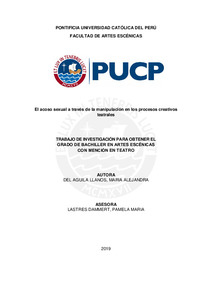| dc.contributor.advisor | Lastres Dammert, Pamela María | |
| dc.contributor.author | Del Águila Llanos, María Alejandra | |
| dc.date.accessioned | 2020-09-11T14:20:02Z | |
| dc.date.available | 2020-09-11T14:20:02Z | |
| dc.date.created | 2019 | |
| dc.date.issued | 2020-09-11 | |
| dc.identifier.uri | http://hdl.handle.net/20.500.12404/17030 | |
| dc.description.abstract | La presente investigación, describe la existencia de acoso sexual en los procesos de
creación escénica. Planteando en primer lugar, las características que tienen estos
espacios de creación, donde predomina la vulnerabilidad del intérprete y la confianza que
este debe tener en su director. Convirtiéndose en un escenario ideal para posibles caso
de abuso de poder o de acoso sexual. En segundo lugar, se presenta y se trata de buscar
una definición de acoso sexual en espacios laborales, partiendo del concepto de propone
la ley jurídica peruana. Y por último, se presenta el caso de Eva Bracamonte y Guillermo
Castrillón, que ayuda a plantearnos las siguientes diferentes preguntas que surgen
alrededor de este evento: ¿Existen límites que se deben respetar para evitar el acoso en
procesos escénicos? Y ¿Qué características se deben tomar en cuenta para detectarlo?
Estas incógnitas son el punto de partida para indagar sobre las formas y métodos que se
tiene en el quehacer escénico y los cuidados que hay que tener. Finalmente, se concluye
que las partes implicadas de un sospechoso caso de acoso sexual durante un proceso
creativo, deben tener como intermediarios a entidades responsables y competentes que
lleven con delicadeza esta situación para lograr obtener una sanción acertada al
responsable. | es_ES |
| dc.description.abstract | The fallowing investigation describes the presence of sexual harassment in the processes
of scenic art creation. In the first place, the nature the of these spaces is discussed, spaces
where vulnerability from the interpreter is necessary as well as trust in their director.
Becoming an ideal setting for possible cases of abuse of power or sexual harassment.
Secondly, a definition of sexual harassment in the work place is presented and described,
based on the concept proposed by the Peruvian legal law. And finally, the case of Eva
Bracamonte and Guillermo Castrillón is presented, which helps to pose the following
different questions that arise around this event: Are there limits that must be respected to
avoid harassment in stage processes? And what characteristics should be taken into
account to detect it? These questions are the starting point to inquire into the forms and
methods that exist in the stage work and the care that must be taken. Finally, it is
concluded that the parties involved in a suspected case of sexual harassment during a
creative process, must have as intermediaries responsible and competent entities that
delicately handle this situation in order to obtain the right punishment for the person
responsible. | es_ES |
| dc.language.iso | spa | es_ES |
| dc.publisher | Pontificia Universidad Católica del Perú | es_ES |
| dc.rights | info:eu-repo/semantics/closedAccess | es_ES |
| dc.subject | Acoso sexual | es_ES |
| dc.subject | Poder (Filosofía) | es_ES |
| dc.subject | Teatro--Estudio y enseñanza | es_ES |
| dc.title | El acoso sexual a través de la manipulación en los procesos creativos teatrales | es_ES |
| dc.type | info:eu-repo/semantics/bachelorThesis | es_ES |
| thesis.degree.name | Bachiller en Artes Escénicas con mención en Teatro | es_ES |
| thesis.degree.level | Bachillerato | es_ES |
| thesis.degree.grantor | Pontificia Universidad Católica del Perú. Facultad de Artes Escénicas | es_ES |
| thesis.degree.discipline | Artes Escénicas con mención en Teatro | es_ES |
| renati.advisor.dni | 9340768 | |
| renati.advisor.orcid | https://orcid.org/0000-0001-8221-2071 | es_ES |
| renati.discipline | 215586 | es_ES |
| renati.level | https://purl.org/pe-repo/renati/level#bachiller | es_ES |
| renati.type | https://purl.org/pe-repo/renati/type#trabajoDeInvestigacion | es_ES |
| dc.publisher.country | PE | es_ES |
| dc.subject.ocde | http://purl.org/pe-repo/ocde/ford#6.04.04 | es_ES |





